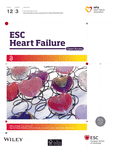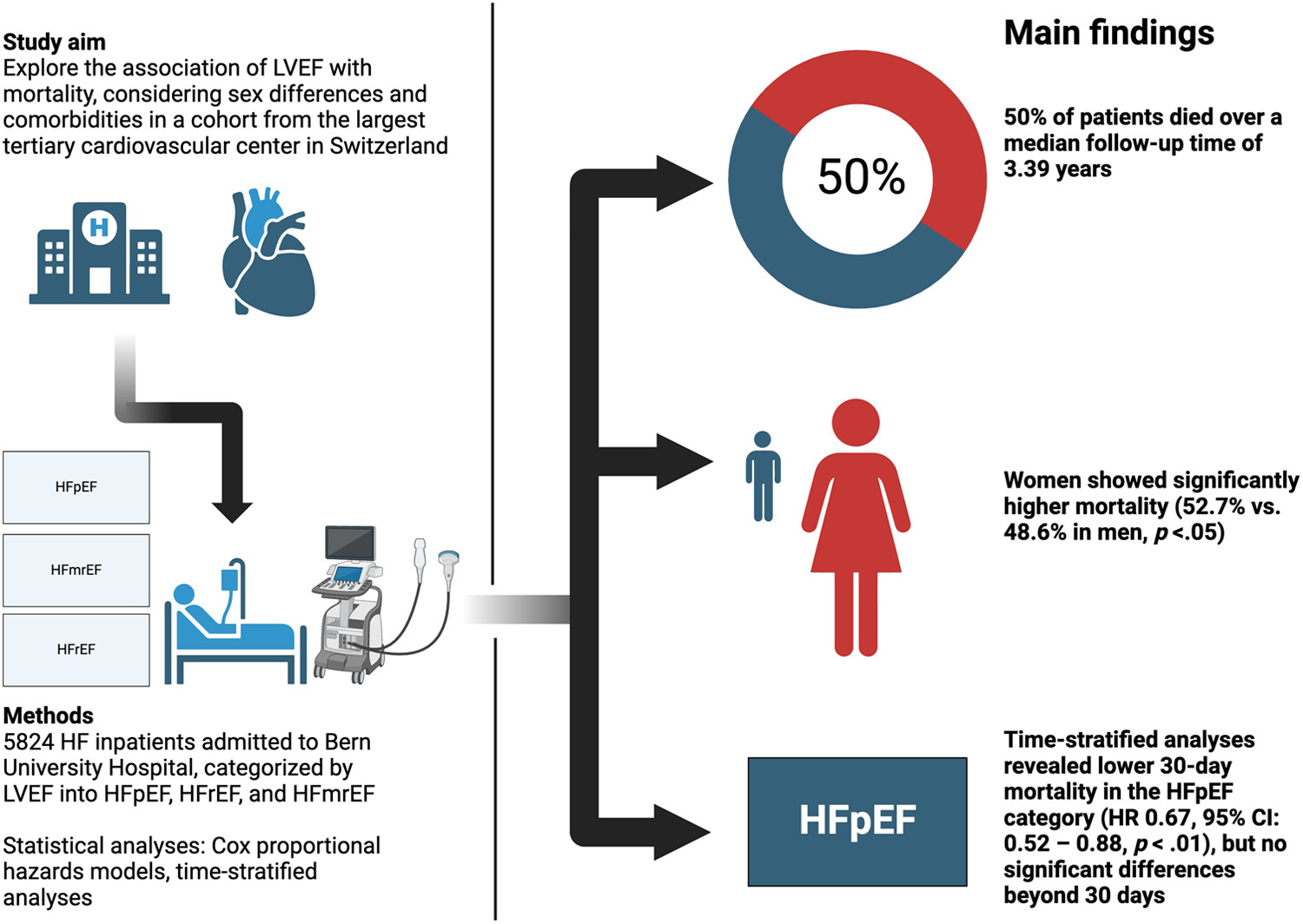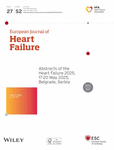Journal list menu
Export Citations
Download PDFs
Issue Information
Editorial
Advancing diagnostics and therapy in transthyretin amyloid cardiomyopathy
- Pages: 1529-1531
- First Published: 26 November 2024
An unexpected ally in heart failure treatment: Unlocking the potential of sodium-glucose cotransporter 2 inhibitors across patient subpopulations
- Pages: 1532-1534
- First Published: 16 November 2024
Biomarkers in heart failure: Traditional and emerging indicators for prognosis
- Pages: 1535-1538
- First Published: 15 November 2024
In a quest for better outcome prediction in cardiogenic shock
- Pages: 1539-1540
- First Published: 21 January 2025
The Critical Role of Comorbidities in Managing Heart Failure with Preserved Ejection Fraction (HFpEF)
- Pages: 1541-1543
- First Published: 16 November 2024
Review
State of precision medicine for heart failure with preserved ejection fraction in a new therapeutic age
- Pages: 1544-1557
- First Published: 23 January 2025
Invasive haemodynamic assessment in heart failure with preserved ejection fraction
- Pages: 1558-1570
- First Published: 08 November 2024
Original Article
Neutrophil-to-lymphocyte ratio: link to congestion, inflammation, and mortality in outpatients with heart failure
- Pages: 1571-1582
- First Published: 02 March 2025
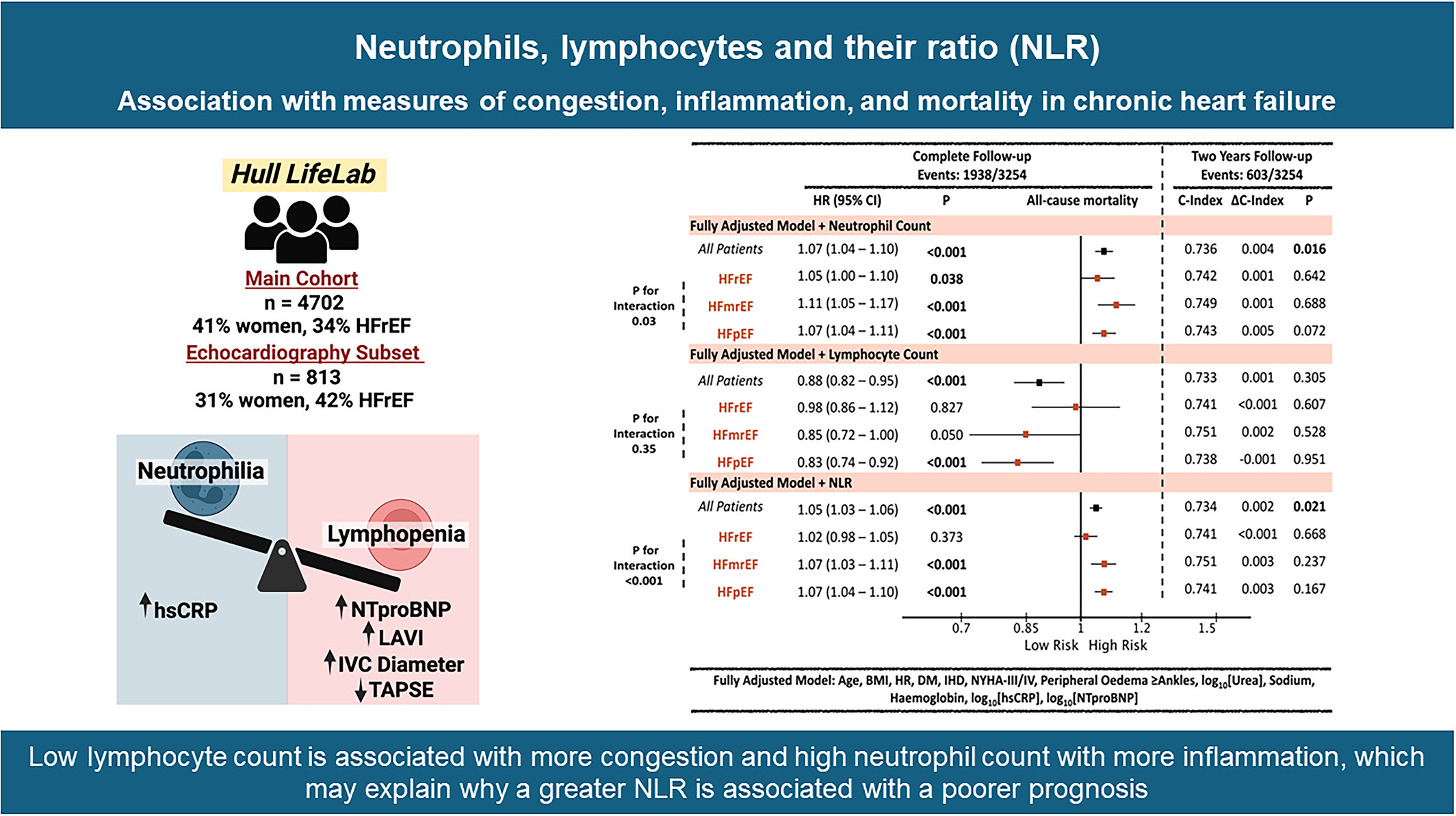
Association of Neutrophil Count, Lymphocyte Count and Neutrophil-to-Lymphocyte ratio (NLR) with All-cause Mortality. We enrolled 4702 ambulatory patients referred to a local HF clinic in the UK (The Hull LifeLab), of whom 813 had detailed echocardiographic assessment (top left). Lymphocyte count correlated inversely with NTproBNP (r = −0.31) and markers of congestion (left atrial volume index (r = −0.25), inferior vena cava diameter (r = −0.24) and positively with right ventricular function (TAPSE); neutrophil count correlated positively with hsCRP (r = 0.31, P<0.001) (bottom left). On the right panel, we report the adjusted hazard ratios (HR) per 1 unit change assessed over the complete follow-up duration with corresponding forest plots for visualization. Further right, we assessed model discrimination at 2 years of follow-up using the C-index. ΔC-index represents the difference between the “C-index of the fully adjusted model + neutrophil count/lymphocyte count/NLR” and the “C-index of the fully adjusted model alone”. Abbreviations used; NLR: neutrophil-to-lymphocyte ratio, BMI: body mass index, HR: heart rate, DM: diabetes mellitus, IHD: ischaemic heart disease, NYHA: New York heart association classification, NTproBNP: N-Terminal Pro-B type natriuretic peptide, hsCRP: high sensitivity C-reactive protein, C-index: concordance index, LVEF: left ventricular ejection fraction, HFrEF: heart failure with reduced left ventricular ejection fraction, HFmrEF: heart failure with mildly reduced left ventricular ejection fraction. HFpEF: heart failure with preserved left ventricular ejection fraction.
Long-term outcomes of electrical storm patients listed for urgent heart transplantation but not transplanted acutely
- Pages: 1583-1593
- First Published: 27 February 2025
Socio-economic status and the effect of guideline-directed medical therapy in the STRONG-HF study
- Pages: 1594-1605
- First Published: 12 February 2025
Prevalence of iron deficiency in acute and chronic heart failure according to different clinical definitions
- Pages: 1606-1619
- First Published: 11 February 2025
Burst steroid therapy and quality of life in patients with acute heart failure: Insights from the CORTAHF trial
- Pages: 1620-1629
- First Published: 11 February 2025
Investigation of left ventricular ejection fraction in a Swiss heart failure population: Insights into mortality and sex differences
- Pages: 1630-1639
- First Published: 10 December 2024
Transcoronary study of biomarkers in patients with heart failure: Insights into intracardiac production
- Pages: 1640-1651
- First Published: 27 December 2024
Training-induced change of diastolic function in heart failure with preserved ejection fraction
- Pages: 1652-1662
- First Published: 12 February 2025
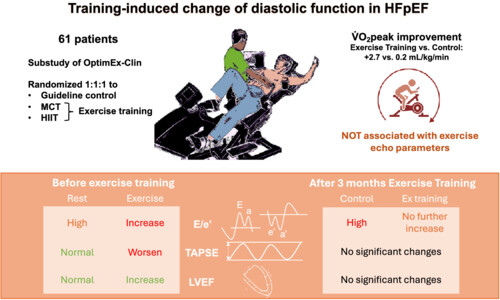
Training-induced change of diastolic function in HFpEF. HIIT, high-intensity interval training; HFpEF, heart failure with preserved ejection fraction; LVEF, left ventricular ejection fraction; MCT, moderate continuous training; TAPSE, tricuspid annular plane systolic excursion; V̇O2peak, peak oxygen uptake.
Mitral valve transcatheter edge-to-edge repair in the elderly—A safe and effective therapy
- Pages: 1663-1675
- First Published: 04 December 2024
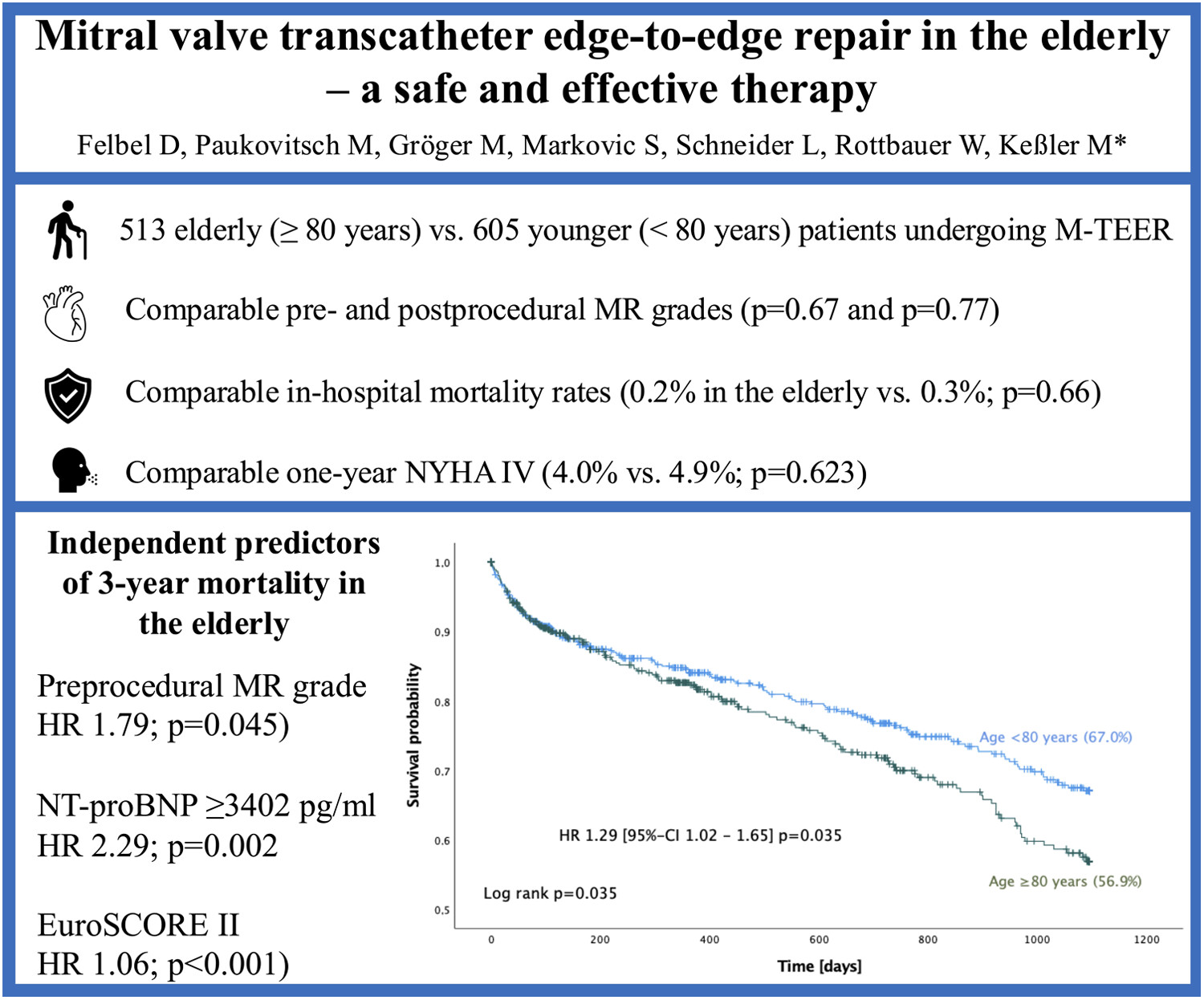
Mitral valve transcatheter edge-to-edge repair in elderly patients is safe and offers comparable mitral valve regurgitation reduction and symptom relief to younger patients. At 3 years, increased all-cause mortality is observed in elderly patients with advanced heart failure and elevated EuroSCORE II.
Baseline kidney function and the effects of dapagliflozin on health status in heart failure in DEFINE-HF and PRESERVED-HF
- Pages: 1676-1681
- First Published: 24 December 2024
Real-world comparative effectiveness of sacubitril/valsartan versus RAS inhibition alone in patients with de novo heart failure
- Pages: 1682-1692
- First Published: 30 January 2025
Incidence of atrial fibrillation in patients with an insertable cardiac monitor and symptomatic heart failure
- Pages: 1693-1702
- First Published: 09 December 2024

Atrial fibrillation (AF) was observed in almost half of patients with insertable cardiac monitor and symptomatic heart failure (HF). One-fourth of the patients had new onset AF and a higher rate of HF events compared with patients without AF. AF incidence was similar in HF patients with preserved versus reduced left ventricular ejection fraction.
Up-titration of medication in patients with new-onset heart failure with and without atrial fibrillation
- Pages: 1703-1713
- First Published: 19 February 2025
Short Communication
Long-term outcomes of apixaban as main anticoagulant in patients with HeartMate 3 left ventricular assist devices
- Pages: 1714-1718
- First Published: 09 December 2024
Study Design
Design and rationale of the eLym™ System for Decompensation of Excess Lymphatic Fluid via the Thoracic Duct in Acute Heart Failure (DELTA-HF)
- Pages: 1719-1726
- First Published: 24 December 2024
Review
Smartwatches in the assessment of heart failure patients in epidemiology and pathophysiology studies: A scoping review
- Pages: 1727-1738
- First Published: 04 February 2025
Immune cell dynamics in heart failure: implicated mechanisms and therapeutic targets
- Pages: 1739-1758
- First Published: 04 February 2025
Elements of effective palliative care interventions in advanced heart failure: A narrative review
- Pages: 1759-1775
- First Published: 19 March 2025
Original Article
Duration of sodium zirconium cyclosilicate treatment and continuation of RAASi therapy after a hyperkalaemia episode
- Pages: 1776-1785
- First Published: 10 December 2024
Implementation of guideline-directed medical therapy in patients with heart failure with reduced ejection fraction (OpTIMa-HF Registry)
- Pages: 1786-1795
- First Published: 05 February 2025
The effect of trimetazidine on cardiac haemodynamics and mitochondrial function in wild-type transthyretin amyloidosis
- Pages: 1796-1806
- First Published: 03 December 2024
Vericiguat improves cardiac remodelling and function in rats with doxorubicin-induced cardiomyopathy
- Pages: 1807-1817
- First Published: 17 January 2025
Assessment of frailty in patients with heart failure: A new Heart Failure Frailty Score developed by Delphi consensus
- Pages: 1818-1831
- First Published: 04 February 2025
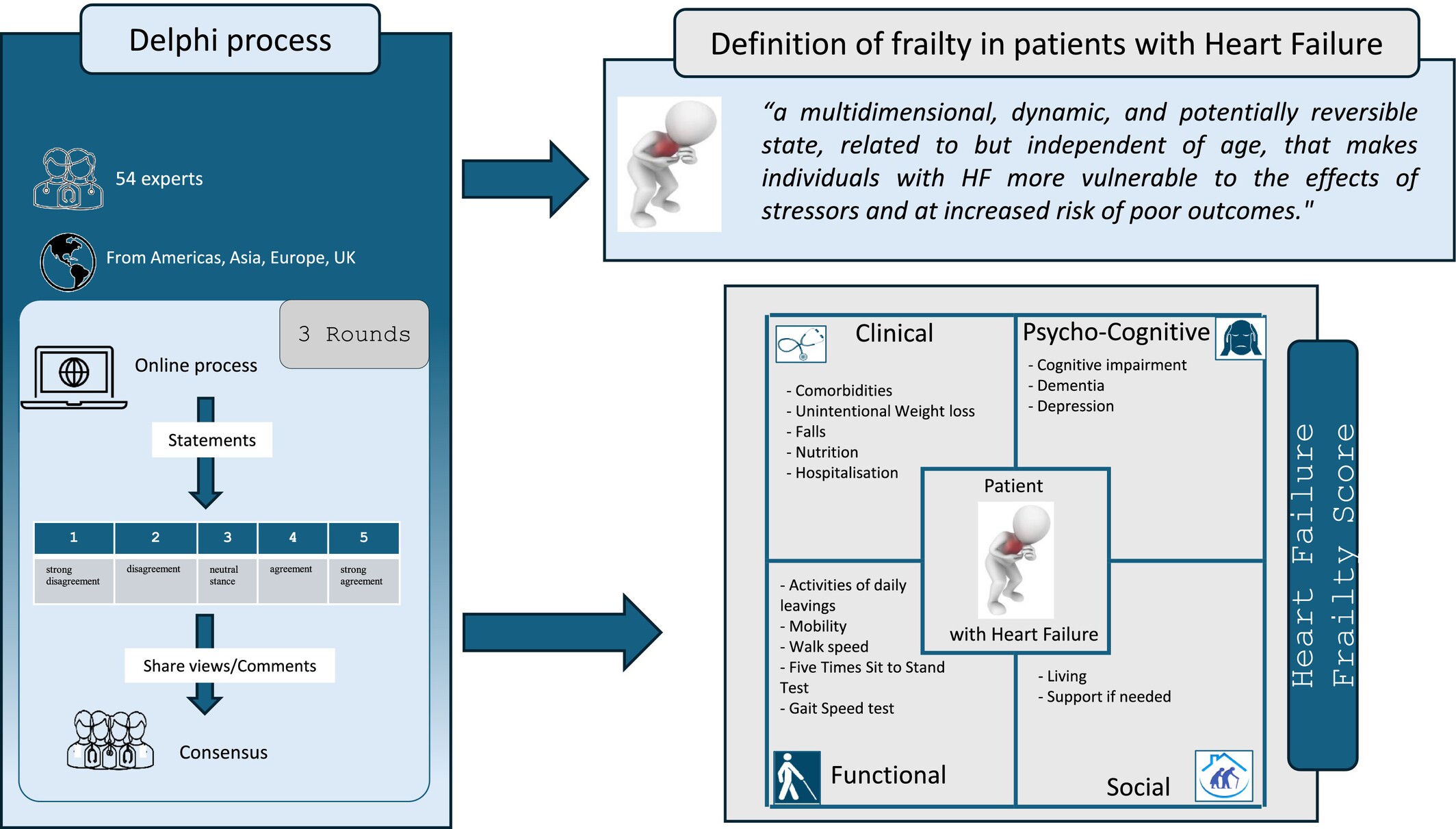
- The HFFS is a new multidimensional tool for the identification of frailty in patients with HF developed through a Delphi process involving 54 international experts in the management of HF and frailty.
- Two versions of the HFFS have been developed after the third round of the Delphi process.
- The shorter version (S-HFFS) can be easily used in busy clinical practice.
Real-world outcomes in cardiac resynchronization therapy patients: Primary results of the SMART registry
- Pages: 1832-1847
- First Published: 26 December 2024
The ADESTE trial: A phase 2 study of enibarcimab, a monoclonal antibody targeting adrenomedullin, in acute heart failure
- Pages: 1848-1860
- First Published: 14 January 2025
Guideline-directed medical therapy rates in heart failure patients with reduced ejection fraction in a diverse cohort
- Pages: 1861-1871
- First Published: 19 January 2025
Discovery of miRNAs unique to actively transcribed erythroparvovirus infection in heart failure patients
- Pages: 1872-1882
- First Published: 19 February 2025
Exercise-induced dynamic mitral regurgitation is associated with outcomes in patients with ischaemic cardiomyopathy
- Pages: 1883-1892
- First Published: 20 January 2025
Pro-adrenomedullin as an independent predictive biomarker for heart failure in atrial fibrillation and flutter
- Pages: 1893-1904
- First Published: 13 January 2025
Severity of tricuspid regurgitation predicts risk of recurrence of atrial fibrillation after pulmonary vein isolation
- Pages: 1905-1915
- First Published: 26 March 2025
Predicting right ventricular failure after left ventricular assist device implant: A novel approach
- Pages: 1916-1931
- First Published: 20 January 2025
Poor communication impairs optimal care of patients with heart failure and erectile dysfunction
- Pages: 1932-1941
- First Published: 19 January 2025
Early genetic screening and cardiac intervention in patients with cardiomyopathies in a multidisciplinary clinic
- Pages: 1942-1955
- First Published: 30 December 2024
Relaxin mimetic in pulmonary hypertension associated with left heart disease: Design and rationale of Re-PHIRE
- Pages: 1956-1964
- First Published: 20 January 2025
Clinical evaluation and outcome in heart failure patients receiving chemotherapy with different anti-cancer agents
- Pages: 1965-1976
- First Published: 13 January 2025
Health-related quality of life across heart failure categories: associations with clinical characteristics and outcomes
- Pages: 1977-1991
- First Published: 27 January 2025
Risk classification for long-term mortality among patients with acute heart failure: China PEACE 4YMortality
- Pages: 1992-2009
- First Published: 17 March 2025
Frailty determinants in heart failure: Inflammatory markers, cognitive impairment and psychosocial interaction
- Pages: 2010-2022
- First Published: 23 January 2025
Randomized trial to assess worsening renal function by adding dapagliflozin for acute decompensated heart failure
- Pages: 2023-2033
- First Published: 31 January 2025
Treatment patterns, outcomes and healthcare resource utilization of obstructive hypertrophic cardiomyopathy in England
- Pages: 2034-2046
- First Published: 12 February 2025
Association between the Tpeak-Tend interval on admission and coronary microvascular dysfunction in Takotsubo syndrome
- Pages: 2047-2056
- First Published: 23 January 2025
Association of plasma metabolites and cardiac mitochondrial function with heart failure progression
- Pages: 2057-2065
- First Published: 10 March 2025
Heart failure, dementia is associated with increased stroke severity, in-hospital mortality and complications
- Pages: 2066-2076
- First Published: 24 March 2025
Heart failure decompensation with cardiogenic shock exhibits distinct sequential inflammatory profiles
- Pages: 2077-2086
- First Published: 09 February 2025
The efficacy and safety of sodium-glucose cotransporter 2 inhibitors in patients aged over 80 years with heart failure
- Pages: 2087-2097
- First Published: 20 January 2025
Cardiopulmonary exercise testing as a prognosis-assessing tool in heart failure with preserved ejection fraction
- Pages: 2098-2106
- First Published: 16 January 2025
Temporal profiling of M-TEER-related complications
- Pages: 2107-2112
- First Published: 26 January 2025
Prognostic impact of gait speed, muscle strength and muscle mass in chronic heart failure—A prospective cohort study
- Pages: 2113-2124
- First Published: 04 February 2025
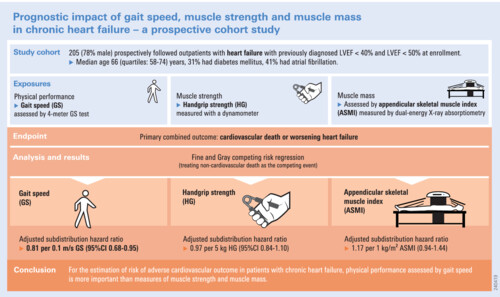
The prognostic impact of the muscle parameters gait speed, handgrip strength and appendicular skeletal muscle index on cardiovascular outcomes was investigated. We prospectively analyzed a cohort of 205 heart failure patients with a median left ventricular ejection fraction of 37% and a median follow-up of 4.7 years. Fine and Gray regression modeling identified only gait speed as an independent predictor of the combined outcome of cardiovascular death or worsening heart failure.
SGLT2i reduce arrhythmic events in heart failure patients with cardiac implantable electronic devices
- Pages: 2125-2133
- First Published: 07 February 2025
Prevalence and prognostic value of different iron deficiency definitions in light chain cardiac amyloidosis patients
- Pages: 2134-2147
- First Published: 08 February 2025
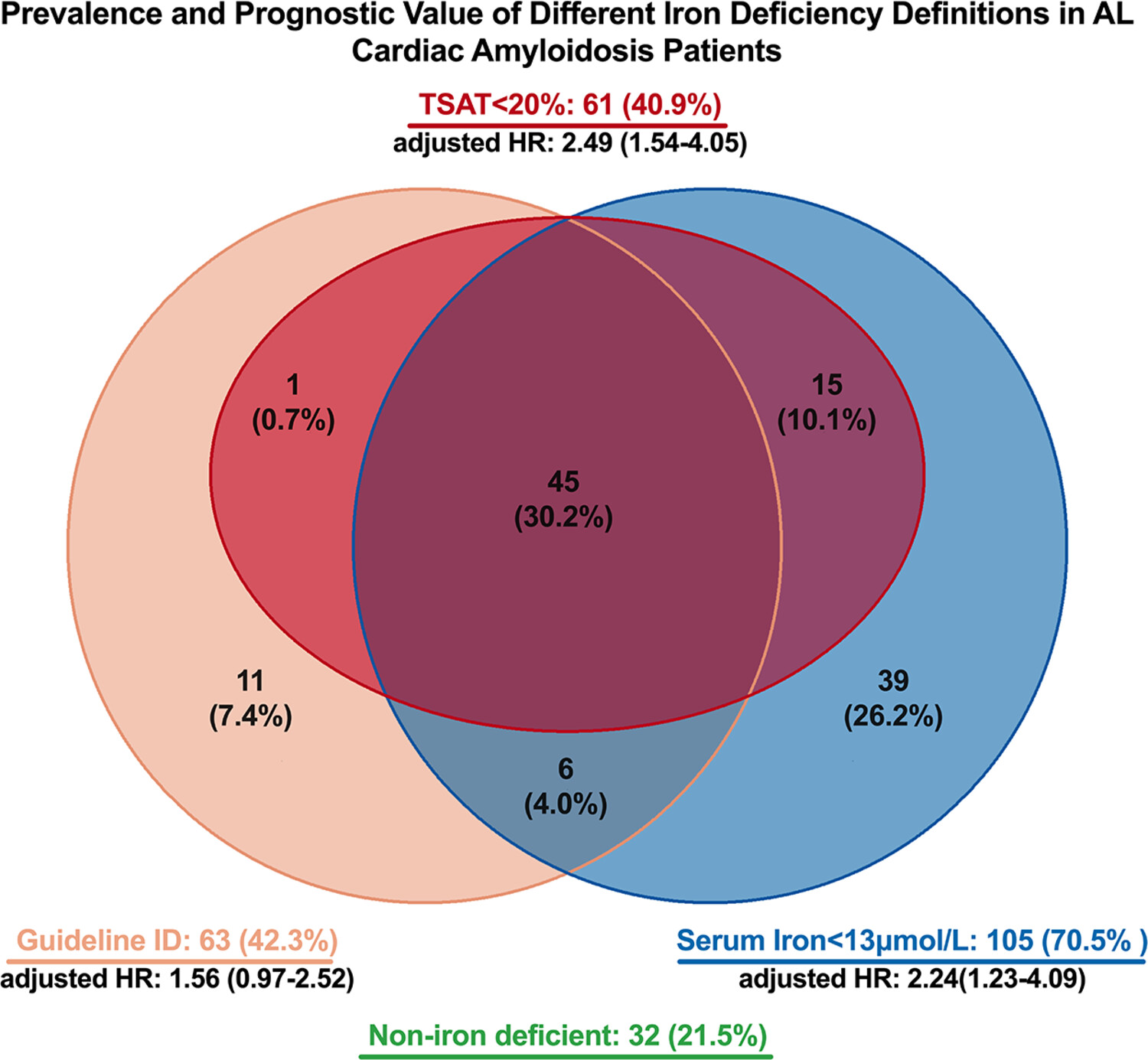
Non-scaled Venn diagram of iron deficiency (ID) according to various definitions and associated outcomes. The prevalence of iron deficiency was high, irrespective of the definition applied. ID defined by TSAT <20% or serum iron <13 μmol/L, rather than the guideline definition, was associated with worse outcomes.
Association of baseline eGFR and incident heart failure on patients receiving intensive blood pressure treatment
- Pages: 2148-2156
- First Published: 26 January 2025
Validation of a biomarker-based mortality score for cardiogenic shock patients: Comparison with a clinical risk score
- Pages: 2157-2165
- First Published: 02 February 2025
Right ventricular dysfunction for prediction of long-term recovery in de novo HFrEF : a PROLONG-II substudy
- Pages: 2166-2176
- First Published: 04 February 2025
Cardiac magnetic resonance left atrioventricular coupling index as a prognostic tool in hypertrophic cardiomyopathy
- Pages: 2177-2189
- First Published: 04 February 2025
Predictors of sustained reverse remodelling in patients with heart failure with reduced ejection fraction
- Pages: 2190-2199
- First Published: 10 February 2025
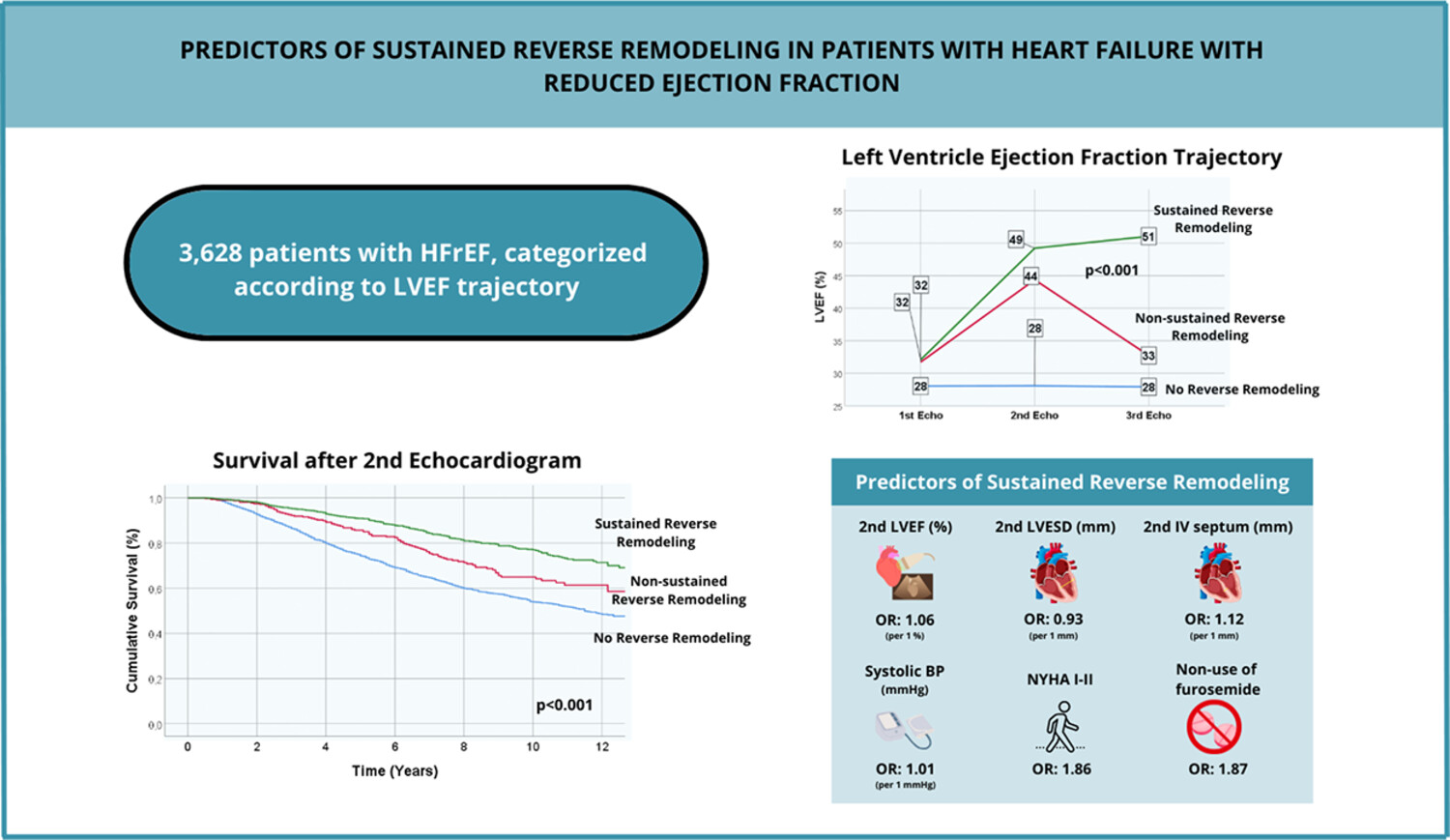
In this retrospective, observational study of a real-life cohort of patients with heart failure with reduced ejection fraction, long-term survival was improved in patients who achieved sustained reverse remodeling. Greater increases in ejection fraction (EF) and reductions in left ventricular end-systolic diameter at the time of EF recovery, greater septal thickness, higher blood pressure, absence of diuretic need, and maintenance of NYHA class I/II were predictors of sustained recovered ventricular function.
Prediction of 90 day mortality in elderly patients with acute HF from e-health records using artificial intelligence
- Pages: 2200-2209
- First Published: 13 February 2025
Global myocardial work index predicts response to biventricular pacing in patients with non-left bundle branch block
- Pages: 2210-2224
- First Published: 20 February 2025
H2FPEF and HFA-PEFF scores for heart failure risk stratification in hypertrophic cardiomyopathy patients
- Pages: 2225-2238
- First Published: 01 March 2025
Secondary sclerosing cholangitis in patients suffering cardiogenic shock
- Pages: 2239-2244
- First Published: 26 February 2025
Comparison of incidence, prevalence and death of aortic stenosis and aortic insufficiency in a nationwide Korean study
- Pages: 2245-2255
- First Published: 24 February 2025
Calpain inhibition in a transgenic model of calpastatin overexpression facilitates reversal of myocardial hypertrophy
- Pages: 2256-2266
- First Published: 02 March 2025
Transcatheter edge-to-edge repair of atrial secondary mitral regurgitation positively influences atrial remodelling
- Pages: 2267-2277
- First Published: 11 March 2025
Decreased endogenous nitric oxide production in acute decompensated heart failure with a reduced ejection fraction
- Pages: 2278-2286
- First Published: 01 March 2025
Inter-atrial block as a predictor of adverse outcomes in patients with HFpEF
- Pages: 2287-2297
- First Published: 01 December 2024
Prognostic value of advanced lung cancer inflammation index in heart failure patients: A comprehensive analysis
- Pages: 2298-2309
- First Published: 03 December 2024
In heart failure, echocardiographic parameters of right ventricular function are powerful tools to predict renal failure
- Pages: 2310-2320
- First Published: 25 February 2025
Trametinib alters contractility of paediatric Noonan syndrome-associated hypertrophic myocardial tissue slices
- Pages: 2321-2334
- First Published: 21 November 2024
Clinical profile, short and long-term outcomes of non-ischaemic cardiogenic shock: A FRENSHOCK sub-analysis
- Pages: 2335-2346
- First Published: 25 March 2025
Clinical Correspondences
Genetic cardiomyopathy mimicking isolated cardiac sarcoidosis: Diagnostic challenges with positron emission tomography
- Pages: 2347-2352
- First Published: 04 February 2025
IgG4-related constrictive pericarditis with previous asbestos exposure: A case report and literature review
- Pages: 2353-2360
- First Published: 25 December 2024
Ten-year follow-up of a case of eosinophilic granulomatous with polyangiitis
- Pages: 2361-2366
- First Published: 13 January 2025
Familial restrictive cardiomyopathy with novel missense variant of uncertain significance in the FLNC gene
- Pages: 2367-2370
- First Published: 06 February 2025
Hypertrophic cardiomyopathy combined with renal and adrenal aplasia in a male with Noonan syndrome from RAF1 variant
- Pages: 2371-2376
- First Published: 10 February 2025
Delayed cardiac consequences unveiled by magnetic resonance imaging in a high-voltage electric shock survivor
- Pages: 2377-2381
- First Published: 04 March 2025
Short Communication
Cardiac myosin binding protein C correlate with cardiac troponin I during an exercise training program in patients with HFrEF
- Pages: 2382-2386
- First Published: 23 January 2025
Sex-related pathophysiological mechanisms may be present before symptoms of HFpEF develop
- Pages: 2387-2390
- First Published: 28 February 2025
Case Report
Refractory heart failure due to acquired aortic coarctation after total arch replacement: find the right antidote!
- Pages: 2391-2395
- First Published: 06 March 2025
Correction
Correction to “Understanding the variability in red cell and plasma volume combinations can help guide management in heart failure”
- Page: 2396
- First Published: 08 April 2025




